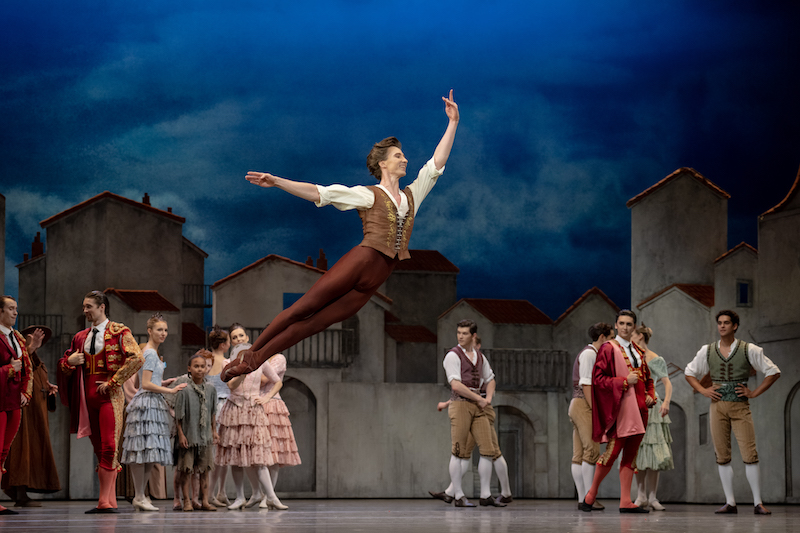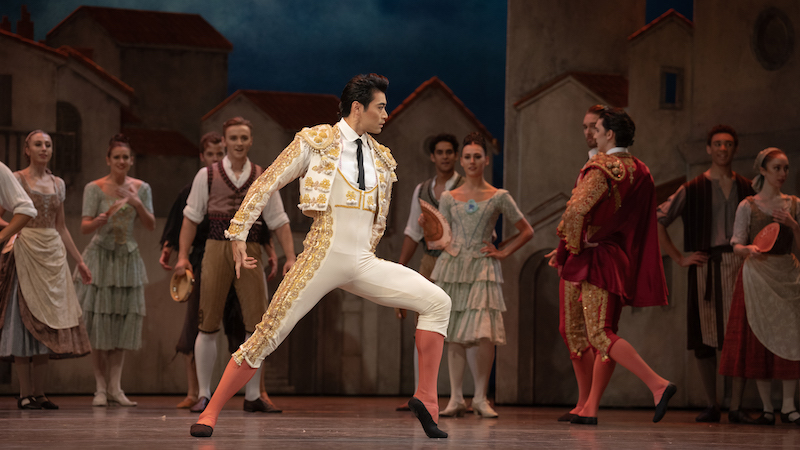It was Carlos Acosta’s new production of Don Quixote that launched the Royal Ballet season in the autumn of 2013, and as it does so again 10 years on, its sunny dynamism is just what the doctor ordered.
Don Q, as it’s known to ballet fans, can be an old warhorse. Russian productions and their variants, all of them drawn from a revised text of 1900, go big on technique and little else: for them it’s all about the backbending jetés and one-handed lifts, the speed of her fouettées and his circling leaps. Careless of dramatic continuity, dancers step out of character every few minutes to take applause. Acosta, who must have guested countless times in such productions, has instead produced a seamless drama – not deep, it’s still a very slender plot, but a drama overflowing with incident, humanity and heart. He himself took the role of Basilio 10 years ago, to Mariañela Nunez’ Kitri (pictured above). She now reprises that role, her sparkling energy undimmed, partnered by a jet-propelled, lean-as-a-whippet Vadim Muntagirov (pictured above and below). Together and apart, they are sensational.
 The glaring anomaly is that the ballet as Marius Petipa wrote it in 1869 is the young lovers’ story, not that of the titular knight. Acosta’s version gently corrects that, bringing the crazy old Don and his comedy squire Sancho Panzo into the frame in every scene, and making us fall in love with them along the way. Playing the Don as a sweet old gentleman in the first stage of dementia, Christopher Saunders makes his delusions of knighthood very touching. Along with Philip Mosley’s Sancho – surprisingly nimble in his fat-suit – they work in some classic vaudeville stapstick with aplomb. Call me a soft touch, but I was helpless when the Don seized a bedpost to serve as a lance, and the bed collapsed. The third member of their crusading party is Rocanante, the Don’s superannuated horse. Hats off to the ROH props department for the fabulously moth-eaten puppet nag, whose front hooves actually do plod along.
The glaring anomaly is that the ballet as Marius Petipa wrote it in 1869 is the young lovers’ story, not that of the titular knight. Acosta’s version gently corrects that, bringing the crazy old Don and his comedy squire Sancho Panzo into the frame in every scene, and making us fall in love with them along the way. Playing the Don as a sweet old gentleman in the first stage of dementia, Christopher Saunders makes his delusions of knighthood very touching. Along with Philip Mosley’s Sancho – surprisingly nimble in his fat-suit – they work in some classic vaudeville stapstick with aplomb. Call me a soft touch, but I was helpless when the Don seized a bedpost to serve as a lance, and the bed collapsed. The third member of their crusading party is Rocanante, the Don’s superannuated horse. Hats off to the ROH props department for the fabulously moth-eaten puppet nag, whose front hooves actually do plod along.
The first Act – by far the longest in the ballet and set entirely in designer Tim Hatley's sun-drenched town square – is so packed with fizzing business and lively choreography that if you were called home at the interval you’d hardly feel shortchanged. Again, Acosta proves adept at fusing elements – such as corps de ballet and principals – that are traditionally kept apart, creating a warm exchange of onstage energy. There is a moment when the choreography calls for Kitri to draw three pretty circles in the air with her foot. The first time Basilio teasingly tries to catch her ankle, he misses. And the second time (to groans from the crowd in the square). But on the third he catches it, drawing his girl into a lovely supported balance, to a huge cheer.
 Given that the music (by Ludwig Minkus, and super-tuneful) is not through-composed, it’s remarkable that the action runs so smoothly over the gaps. My guess is that the few ever-so-brief hiatuses on opening night were unintended, and will have been ironed out by the time you read this. Act II, when the couple elope to a gypsy encampment, is where this production diverges most from tradition, swapping the usual demi-caractère dances of the gypsies for a flamenco-lite session around the campfire, complete with guitar and some very sexy moves. When the lead gypsy-woman literally rips off the shirt of her man to encourage him to dance, you sit up and pay attention.
Given that the music (by Ludwig Minkus, and super-tuneful) is not through-composed, it’s remarkable that the action runs so smoothly over the gaps. My guess is that the few ever-so-brief hiatuses on opening night were unintended, and will have been ironed out by the time you read this. Act II, when the couple elope to a gypsy encampment, is where this production diverges most from tradition, swapping the usual demi-caractère dances of the gypsies for a flamenco-lite session around the campfire, complete with guitar and some very sexy moves. When the lead gypsy-woman literally rips off the shirt of her man to encourage him to dance, you sit up and pay attention.
In a ballet brimming with colourful minor roles, some were memorable on opening night: Thomas Whitehead's ludicrously useless Ganache, the rich fop Kitri's father wants her to marry, who permanently trips over imaginary shoelaces; and Ryoichi Hirano's steely Espada, the toreador (pictured above), whose name says it all – he dances as if his body were a sword. It's all impossible nonsense, of course – "a phantasmagoria of lived experience" someone has called it. But the joy that emanates from this production is real enough.














Add comment